


DIY Tiling
Fixing Or Laying Tiles
Are you ready to start laying your tiles? Here’s everything you need to know about how to fix or lay your tiles once your surface is clean and ready - see our Surface Preparation Guide before you start.
In this section, we run through everything you need to know about fixing your tiles to walls and floors in your kitchen, bathroom and outside areas.
Click on any topic below and we’ll take you directly to our tips. Come back to this index at any time if you need more information.
| How to tile a floor | We cover all of the important steps for laying floor tiles. We recommend that you also read our guide and video tutorials. |
| How to tile a wall | We cover all of the important steps for laying wall tiles. We recommend that you also read our guide and video tutorials. |
| Tiling a wet area floor | Our experts give you all the tips and tricks they’ve learned over years of practice for tiling wet areas like bathrooms and laundries. |
| Tiling a wet area wall | In this section, we guide you through everything you need to know to get your wet area walls right. |
| How to tile a kitchen splashback | Tiling a kitchen splashback is one of the best DIY projects when learning how to tile and the difference a great splashback can make will WOW you! We get you started with our expert tips. |
| How to lay natural stone | Natural Stone is generally thicker and heavier than porcelain or ceramic tiles, so there are a couple of important points to note about the surface that the stone will be laid on and how to handle stone. |
| Installing basalt | Extra care is needed when installing basalt - our experts guide you through the top tricks and tips. |
| How to tile an external area | Tiling your external area will be a breeze when you follow the steps and tricks our experts have written for You. |
| How to fix mosaics | Our experts run you through the top tricks for working with sheets of mosaics to avoid rookie errors like starting in the wrong spot. |
| Using a levelling system | Levelling systems are great when tiling with large rectified tiles and can make the job a lot easier. No one wants an undulating floor or tile corners that aren’t level! |
| Tile spacers & grout width | To get even spaces and a professional look, you’ll need tile spacers, in this section we run through how to use them. |
| How to use a rubber grouter | Using a rubber grouter makes the task of grouting tiles much easier! We show you how in this section. |
| Top 10 fixing tips | Our experts spill the tea on their top fixing and tiling tips. We’ve done this before in tens of thousands of homes around Australia, and we’ve heard all the rookie mistakes new DIYers have made - learn from these mistakes so you get it right the first time. |
| 10 things NOT to do when tiling | As a DIYer you might not know about the big no-nos of tiling - check them out and save yourself any headaches. |
Our Hot Tip: Our DIY experts have created a super handy DIY guide that will be your best friend throughout your DIY journey - click here to download. If you’re ever unsure about any stage of your DIY journey, give your local store a buzz and speak to our in-store experts.


You must wear a mask when cutting tiles. Brick Bond Laying is recommended between 25 – 33%.
How To Tile A Main Floor
Our expert tiler mates have put together this video giving their hot tips and advice from years of experience to ensure a great finish for your project.
How To Tile A Floor
With the right information and a little planning, laying floor tiles is the perfect home renovation project for any DIY enthusiast - or even the casual hobby DIYer.
These 5 steps will take you through how to lay tiles once you have prepared your substrate appropriately and waterproofing (if required).
Step 1 Start with your adhesive. If the adhesive is supplied in powder form, follow the manufacturer's instructions to mix. An electric drill that operates at low speed and fitted with a suitable mixing attachment will come in handy to ensure the adhesive is mixed well.
Once mixed, your adhesive should be about the same consistency as toothpaste.
Spread about one square metre of adhesive (or as much as can be laid without it beginning to skin or dry) where you will start laying your tiles. It's a good idea to start along the straight line you would've drawn during the laying out stage.
See our What You’ll Need page for the sized notched trowel required. For most larger sized floor tiles, we recommend you use a 12mm notched trowel to spread the adhesive. By using a notched trowel, the adhesive is applied in an even thickness across the floor. The notched trowel leaves little ridges of adhesive on the floor. Once the tiles are "bedded" into place these notches will flatten out to leave a bed of adhesive half the ridge thickness. Back-butter or spread a coat of adhesive on the back of tiles larger than 40 x 40cm as well as tiles with ridges on the back to ensure full adhesive contact with the tile.
Our Hot Tip: Our dedicated how-to page for surface preparation will ensure you are setting yourself up for success so your tiling job will look amazing and last for years to come. Check it out here.
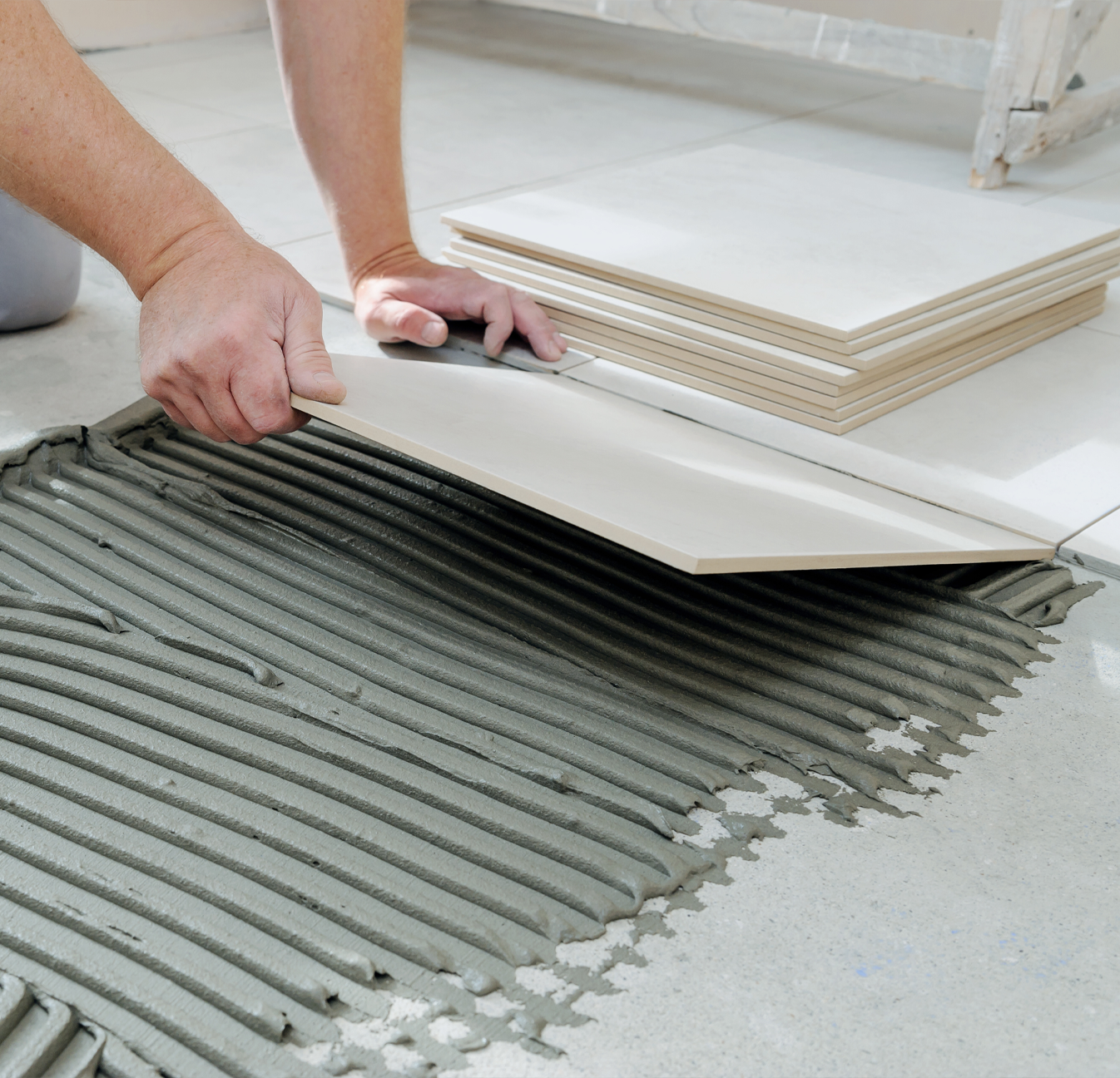



Step 2 Place each tile in position with a firm push and bed it into place with a slight sliding motion across the notches of the adhesive. The aim is to leave no voids or air pockets under the tile so that the adhesive makes full contact with the tile. Every now and then, lift a tile to check that the back is completely covered with adhesive.
Step 3 As you lay the tiles, use appropriately sized grout spacers to set the grout joints and to make small adjustments to the tile placement (the grout width should take into account the size variation of the tile). This keeps all grout joints looking straight and even. Check the level of the installed tile that is flat and level with the surrounding tiles as you go.
Using a tile levelling system - good ones also double as grout spacers - will make it a lot easier to achieve a smooth, level finish without any lipping. Follow the manufacturer's instructions, positioning the tile levelling system towards the corners of each tile. Different systems use either a screw cap or wedge to adjust the level of the tiles until the adhesive fully dries.
Step 4 Clean off any excess adhesive from the tile surface as you go, using a damp sponge. Ensure that the space between tiles is free from excess adhesive and there is space for the grout. Don't forget to keep your gloves, tools and your working area clean and tidy as you work. Leave the tiles to fully dry without walking over them for at least 24 hours.
Step 5 Once the tiles are laid and the glue is fully dry, remove the grout spacers and carefully knock out any levelling clips. It is important to knock them out in the same direction as the grout line. You may see some excess glue residue between the grout lines. This should be carefully removed and vacuumed up. Keep the area clean and ensure that debris does not lodge in the gaps between tiles prior to grouting.
How To Tile A Wall
With the right information and a little planning, laying wall tiles is the perfect home renovation project for any DIY enthusiast - or even the casual hobby DIYer.
Before you start laying any tiles, make sure you spend a little time reading through our guides to measurement, what you need, surface preparation and layout.
Download our DIY Tiling Guide and also check out our 10 top tiling tips and How to Tile - DIY Tiling Made Easy YouTube series before you begin to make sure you're well prepared for a job.
These steps focus on fixing wall tiles. If you are also tiling a floor, check out our guide to installing floor tiles.
Step 1 Follow the adhesive manufacturer’s instructions. Spread the adhesive on the wall with an appropriately sized notched trowel for the size of tile you selected (see our What You’ll Need section). When applying adhesive for wall tiles we always recommend that the notches run horizontally across the wall.
By using a notched trowel, the adhesive is applied in an even thickness across the wall. The notched trowel leaves little ridges of adhesive on the wall. Once the tiles are "bedded" into place, these notches will flatten out to leave a bed of adhesive half the ridge thickness.
Our Hot Tip: Before you get into it, check your boxes of tiles to ensure the shade batch is acceptable and that you have sufficient quantities (with 10% spare) to complete the project.
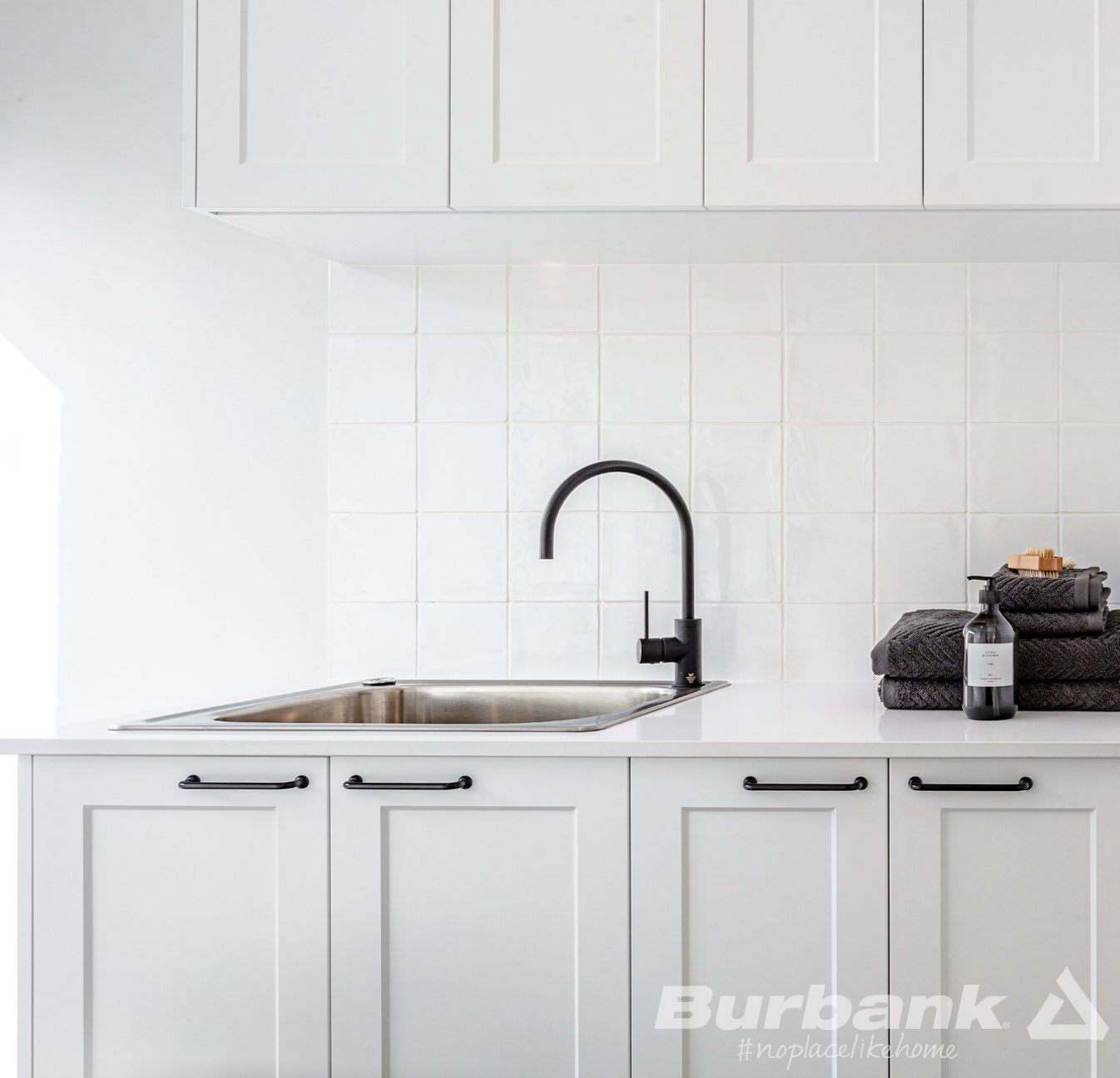

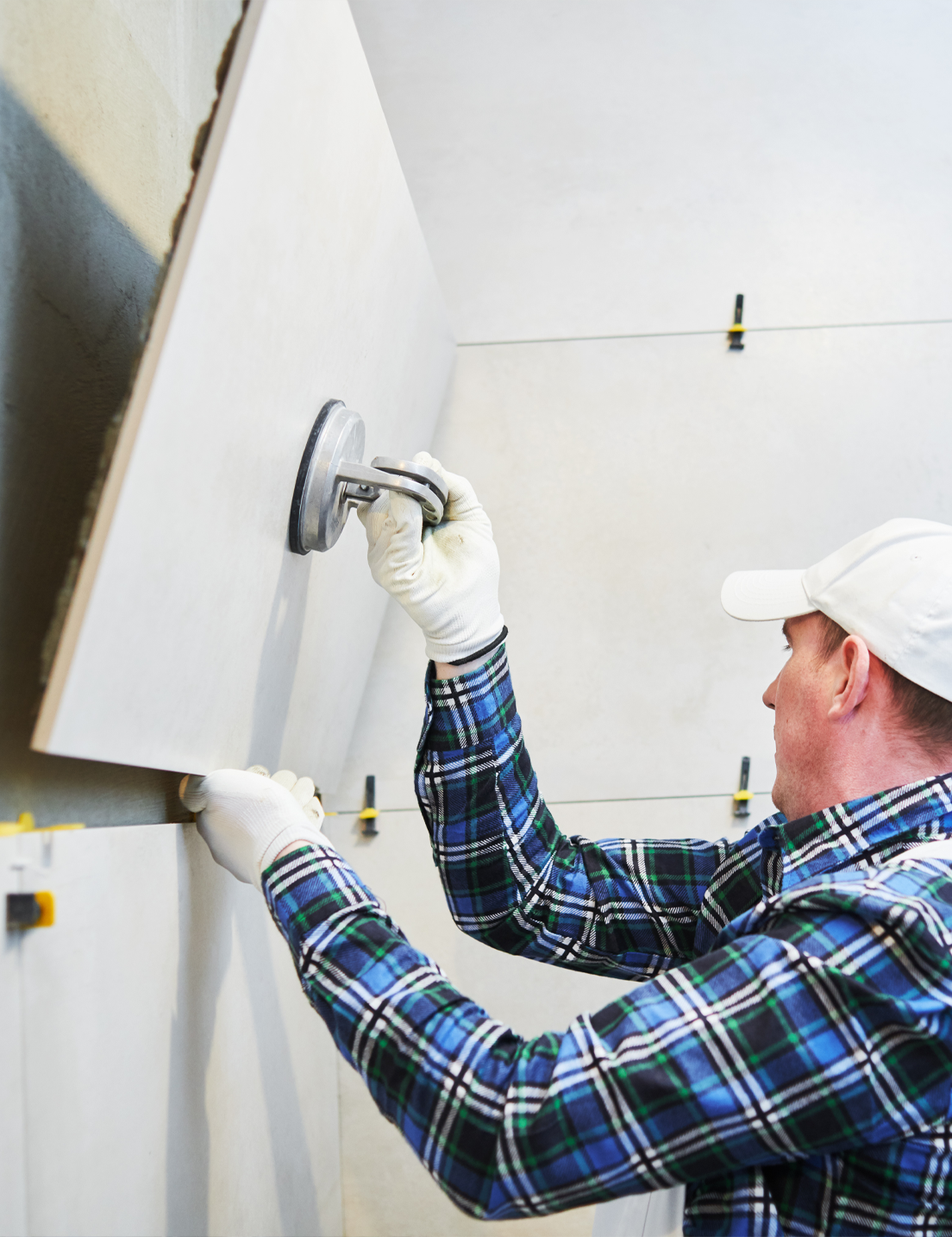

Step 2 Press the tile into the adhesive with a small sliding motion across the ridges. The key to success is to make sure that the tile is flat, firm and that you have full contact coverage with the adhesive on the back of the tile. You want to avoid any hollow spaces behind the tiles.
If there are any gaps between the tiles and the batten at the bottom of the wall that you secured during the layout stage, use wedges to hold them up, keeping the top of the row level. It’s important to make sure the first row is completely level.
Step 3 As you add tiles, place one arm of a tile spacer between tiles to keep the grout joints uniform. These will be removed later, before grouting. Check the flatness and level of the tiles as you lay them.
If you are installing very large tiles on the wall, a tile levelling system will ensure there is no lippage between the tile surfaces. A good levelling system can also double as a tile spacer. Don’t tighten any tile levelling system on your first row of wall tiles until you’re completely happy with where the tiles are.
Step 4 Continue adding tiles to the wall, row by row, keeping the surface and joints clean of adhesive and checking that they’re level and joints are straight as you go.
Step 5 Once the glue has dried, remove any tile spacers, wedges or levelling clips and knock out any levelling caps. You must knock levelling clips out in the same direction as the grout lines. Follow the manufacturer's instructions.
With the wall tiles securely laid and the adhesive is fully dried, the next step is grouting.
Our Hot Tip: The secret to tiling a wall perfectly is all in the edges: the bottom row of tiles and the “column” of tiles in the corner need to be perfectly level.
How To Tile A Bathroom, The Whole Process Explained.
Our expert tiler mates have put together this video, giving their hot tips and advice from years of experience to ensure a great finish for your project.
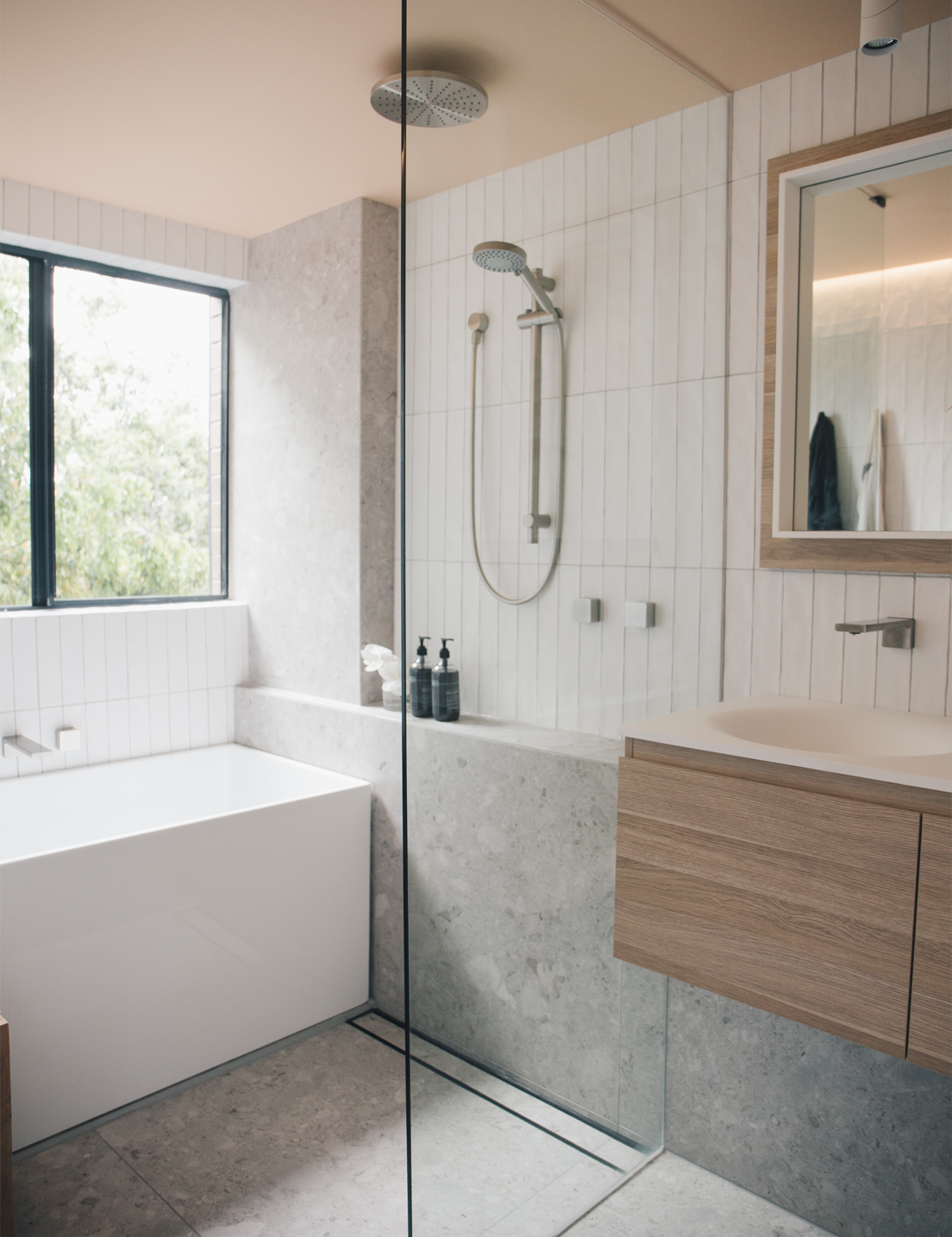

Tiling A Wet Area Floor
Before you start tiling, be sure you have checked out our other pages on measuring, what you’ll need, surface preparation (including waterproofing), and layout.
Tiling a bathroom floor is no more difficult than any other room, but as it’s a wet area it’s also all about getting your waterproofing right first and ensuring you have created correct falls.
When tiling a wet area floor, the adhesive must be compatible with the waterproofing membrane and bear in mind, the adhesive may take longer to dry than a dry area (See the section on fixing floor tiles).
Before you start, ensure you have completed the steps below;
- Measured
- Prepared The Surface For A Wet Area
- Planed the Layout and Dry Lay
- Cut Your Tiles and Dry Lay Again
Unlike floors in other rooms, your bathroom or wet area floor will include a "fall" - a very slight slope that allows water to flow towards the drain and prevent your bathroom from flooding. These may already be built into the surface you're tiling over, but if you need to create a fall (like in a shower base), head back to our Surface Preparation page for a step-by-step guide.
Our Hot Tip: Our DIY experts have created a super handy DIY guide that will be your best friend throughout your DIY journey - click here to download.
Tiling A Wet Area Wall
Tiling the wall/s in your bathroom is straightforward. The fixing method is the same as with dry area walls. Remember when tiling a wall or floor in a wet area, the adhesive must be compatible with the waterproofing membrane and the adhesive may take longer to dry. The difference between a bathroom and most other rooms is that you'll probably need to make a few extra cuts to your tiles to make holes for your tapware and plumbing. See our section on tile cutting for details.
Before you start, ensure you have completed the steps below;
Our Hot Tip: Our DIY experts have created a super handy DIY guide that will be your best friend throughout your DIY journey - click here to download.


How To Tile A Kitchen Splashback
Our tiler mates run you through how to tile a splashback - Let the fun begin!
How To Tile A Kitchen Splashback
The splashback is a key focal point of any good kitchen design. Getting the details right and following through with a high-quality finish on your kitchen splashback tiles can make all the difference to the room that is the heart of your home. Take the time to look at the video and read our guides to learn how to tile a kitchen splashback yourself for the best results on a budget!
Tiles around 200x200mm up to 300x600 are easier to lay, while mosaics are a little more challenging. Give yourself the skills and know-how you need to bring your best splashback ideas to life. A huge slab, that’s a tile up to 3m x 1m is also on-trend, but that one is for the experts to lay. We recommend you call an experienced tiler to install slabs.
Follow the steps below;
- Step 1: Planning
- Step 2: Prepare and clean the surface
- Step 3: Check before you begin
- Step 4: Tile Installation
- Step 5: Grouting
- Step 6: Silicone sealing
Our Hot Tip: Our DIY experts have created a super handy DIY guide that will be your best friend throughout your DIY journey - click here to download.


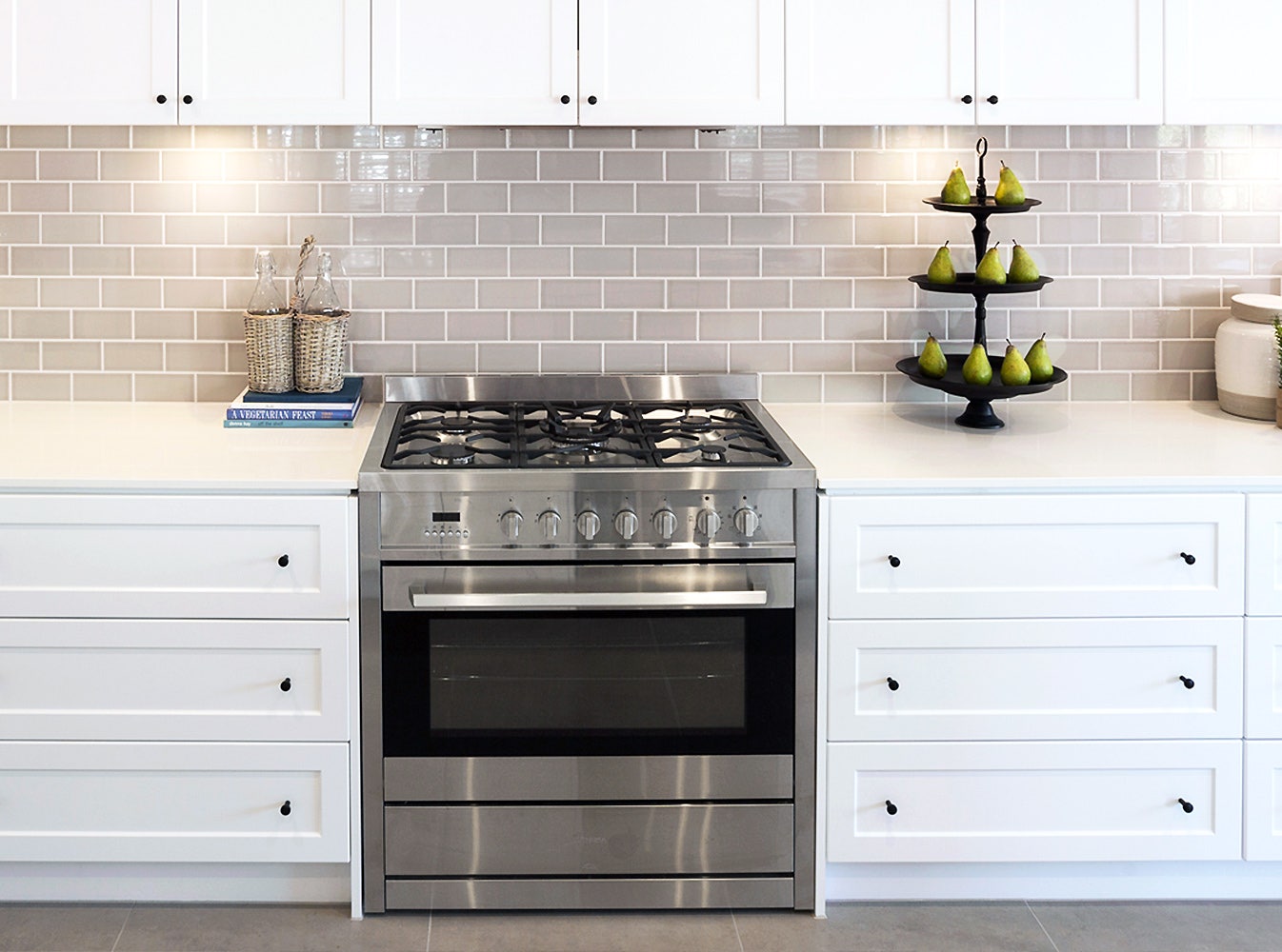

Step 1 As you plan your new splashback, see our useful reference pages for a list of tools you may need, how to calculate the number of tiles you will need. Your local Beaumont Tiles store will be able to help with product selection, suitable adhesive and grout recommendations.
Step 2 Any tiling job will only be as good as the surface it’s laid on. It’s important to ensure that, no matter what surface you’re tiling on, the surface is firm, level and clean of dust and debris.
Plasterboard is one of the most common indoor wall surfaces but is not suitable for tiling over without preparation. If you tile directly onto plasterboard, you will be adhering tiles to a paper surface and although this may present little problem in dry areas, if the plasterboard is subject to moisture, it may deteriorate causing failure. If there is any risk of moisture being present, only use a suitable moisture-proof plasterboard product or conventional plasterboard can be waterproofed so talk to your Beaumont store for the best waterproofing solution that is compatible with your tile adhesive and tile. Also, check out the advice about other substrate surfaces you can tile on.
Our Hot Tip: Everything you need to know about tiling a splashback is in our handy booklet here.
Step 3 Before you begin tiling a kitchen splashback, ensure that the back of the benchtop is siliconed to the wall. Cover the benchtop with some off-cut sheeting or heavy drop sheets. If there are exposed wires at powerpoints you must turn off all power at the switchboard.
At this point, you should also check your boxes of tiles to ensure the shade batch is acceptable and that you have sufficient quantities (with 10% spare) to complete the project.
You can dry lay tiles in the area to check the blend and position before installing, especially with natural stone, mosaics or tiles with a Variation Rating of V3 or V4. Decide where you want to start tiling. Think about your tile laying pattern and where you might need to cut tiles to fit. Usually, if there is an exposed edge, start one tile in from the edge.




Step 4 Follow the manufacturer’s instructions to mix your adhesive. Spread about one square metre of adhesive or as much as you can manage to tile in 15 minutes (less if it's warmer or you are new to this). You need to have the tiles bedded in the adhesive before it begins to skin over.
Use an appropriately sized notched trowel for the tile size (see the tools required list and the adhesive instructions). When applying adhesive for wall tiles, we always recommend that the notches run horizontally across the wall.
Press the tile into the adhesive. The key to success is to make sure that the tile is flat and level and that you have full contact coverage of the adhesive on the back of the tile. You want to avoid any hollow spaces behind the tiles. Lift a tile occasionally to check you have complete adhesive contact all over the tile.
If laying mosaics, you can use a grout float to push the sheets down to give them a flat finish but don’t press so hard that the adhesive fills the joints. Don’t forget to clean off excess adhesive as you go.
It is important to keep all joint widths straight and the same width. Place one arm of a tile spacer between tiles to keep the grout joints uniform. These will be removed later before grouting. Check the flatness and level of all tiles as you lay them.
Step 5 It is important to let the adhesive fully dry before grouting, especially if you are installing over a waterproofing membrane with a natural stone mosaic that will absorb moisture from the adhesive. Remove any tile spacers and move on to grouting. Our super handy video shows you how to grout here.
Step 6 After grouting it is important to install a bead of silicone along the internal corner between the splashback and the benchtop and in any vertical corners. These silicone beads act as movement joints, remaining flexible to withstand any minor movement.
Using a caulking gun, run the bead of silicone continuously along the joint. After wetting with a smoothing agent, use a paddle pop stick to smooth the joint. Remove any excess, spray again with a smoothing agent and smooth over the surface again.
Our hot tip: Cooking with love can often result in spills and splashes (hence the name 'splashback!) We suggest sealing splashback grout annually to keep clean up as easy as possible as your grout looking as good as new for years to come.


How To Lay Natural Stone
Laying natural stone is similar to laying ceramic or porcelain tiles but with slight differences. Generally, we recommend using professional installers for laying stone tiles; but the careful and thorough do-it-yourselfer can also achieve a professional-looking finish. Our staff are always available with helpful advice and tips, and we can recommend a professional installer if you choose to use one.
Natural stone should be unpacked and fully dried before installation. If the stone is damp it will be darker in colour but lighten as it dries. It is always recommended to dry lay the stone before installation to check the colour shades and pattern placement before fixing. Put aside any pieces you don’t like as much and they can be used for cutting.
Any tiling job will only be as good as the surface it is laid on. The substrate or surface to be tiled should be flat, firm, dry and clean of all contaminants. See the sections on preparation and laying out exterior areas.
The ideal substrate surface for natural stone is a properly prepared and dried (for 28 days minimum) concrete slab. Plan and mark the centre lines and tiling layout in the area in the same way as you do when installing floor tiles or wall tiles.
Our preferred method is to fix with a cement-based, flexible adhesive that is specifically recommended for installing natural stone and that is suitable for the conditions outside. Always use a white or light colour adhesive for light-coloured and white stones to avoid discolouration. Never install stone during extremely high or low temperatures. Ideally, install between 10℃ and 25℃. Never store stone in direct sunlight before installing (so the stone does not become hot and cause the adhesive to skin).
Natural stone is more absorbent than porcelain tiles so moisture is absorbed from the adhesive into the stone, darkening the colour. While some stones are specifically described as moisture sensitive and require special fast setting adhesives, as a general rule with natural stone, the faster the adhesive sets, the better. This will minimise moisture absorbed and assist in drying out the stone fully before grouting with minimal discolouration or curling.
Our Hot Tip: Our handy DIY Made Easy for Outdoor tiles guide is here to help you further!




Always refer to the manufacturer’s guidelines when using adhesives. The key to a successful installation is to work in small areas of one or two tiles at a time if the stone size is large. Only spread enough adhesive that you can cover with stone before the adhesive skins. Apply adhesive to the substrate with a 12mm notched trowel and in addition, back-butter each piece of stone with adhesive before it’s laid.
Push the stone into the adhesive with a sliding motion across the ridges to fatten the ridges and make full contact with the back of the stone. Occasionally lift a piece of stone to ensure you achieve full contact with the back of the stone. Ensure any excess adhesive is immediately removed from the surface and that joints and the area (along with your hands or gloves) are kept clean. Always use a back butter technique to cover the entire surface. Never spot fix (or dab fix adhesive). If the glue is applied in spots or blobs it may not only make the stone more prone to cracking by leaving voids beneath the stone, but part of the adhesive may seep through from those spots to the front of the stone and alter the colour in a corresponding spot on the stone face.
Use tile spacers to maintain straight grout lines or if the stone tiles are large, use a tile levelling system to ensure smooth, lip free joints. The tile levelling system will also act as a joint spacer.
All cuts should be completed with a diamond blade wet saw to achieve a clean, straight cut. The cut stone tile should be cleaned and dried before installation. Ensure you use gloves, protective hearing and eyewear and a respirator when cutting natural stone. We do not recommend dry cutting. See our information on safe cutting.
Protect the stone from the rain and allow the installed stone surface to completely dry before walking on it. Ensure all tile spacers or levelling system clips are removed before preparing to grout.
After installation, all natural stones need to be sealed regularly to keep them looking as nature intended. Check out our suggested maintenance plan right here.
Installing Basalt
Installing Basalt is a little different - here’s what you need to know. We recommend that Basalt is sealed on 5 sides before it is installed (the face and edges, but not the back). A rapid setting adhesive for moisture-sensitive stone should be used.
When laying basalt, always use a back butter technique to cover the entire back surface of the stone as well as applying adhesive to the substrate. Never spot fix (or dab) as adhesive spots may seep through and alter the colour of an area on the front of the stone.
Dark grout should be used with basalt applied to the grout lines plus a thin application across the whole tile. If it is only applied to the edges, a picture frame effect will occur.
While we recommend sealing basalt (and all natural stone) before installing, we also recommend applying a final coat of sealer once basalt has been laid, grouted and is completely cleaned.
Our Hot Tip: Our specialists have put together a Stone Specialists brochure to help you out and show you our beautiful range to inspire you including tips from landscaping king, Dave Franklin.
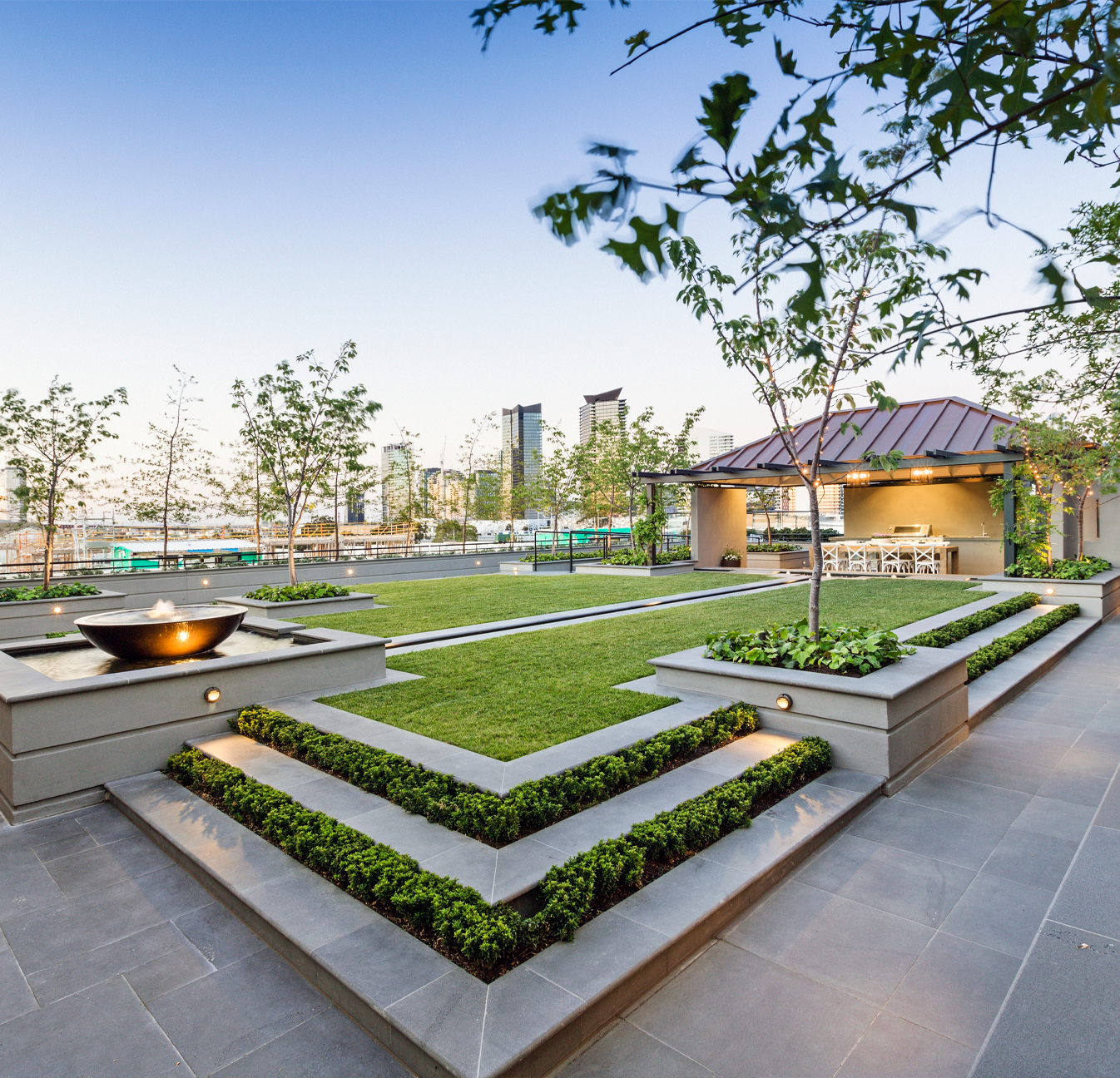



How To Tile An External Area
Any tiling job will only be as good as the surface it is laid on. The substrate or surface to be tiled should be flat, firm, dry and clean of all contaminants. See our sections on surface preparation and laying out exterior areas. The ideal substrate surface for installing outdoor tiling is a properly prepared, cured and dried (for 28 days minimum) concrete slab.
Our preferred method is to fix outdoor tiles with a flexible adhesive that is compatible with the tile material and substrate and that is suitable for external conditions. Never install tiles during extremely high or low temperatures. Ideally, install when the temperature is between 10℃ and 25℃. Never store tiles in direct sunlight before installing (to avoid the tiles becoming hot and causing the adhesive to skin).
Always refer to the manufacturer’s guidelines when mixing and using adhesives. The key to a successful installation is to work in small areas of one or two tiles at a time if the tile size is large, applying adhesive to the substrate with a 12mm notched trowel and in addition, back-butter each tile with adhesive prior to it being laid to ensure complete contact between the adhesive, substrate and tile.
Push the tile into the adhesive with a sliding motion across the ridges to fatten the ridges and make full contact with the back of the tile. Occasionally lift a tile to ensure you achieve full contact with the back. Ensure any excess adhesive is immediately removed from the surface and that joints and the area (along with your hands or gloves) are kept clean. Never spot fix (or dab fix adhesive). If adhesive is only applied in spots or blobs it makes the tile prone to cracking or lifting in the future by leaving voids beneath the surface.
Use tile spacers to maintain straight grout lines and if the tiles are large, use a tile levelling system to ensure smooth, lip free joints. The tile levelling system will also act as a joint spacer.
A diamond blade wet saw is the ideal tool for cutting outdoor tiles to achieve a clean, straight cut. All cut tiles should be cleaned and dried prior to installation. Ensure you use gloves and eyewear when cutting by score and snap along with hearing protection and a well fitted P2 respirator mask when cutting with power tools. We do not recommend dry cutting. See our information on safe cutting.
Protect any freshly laid tiles from rain and extreme weather and allow the installed tiles to completely dry before walking on them. Remove all tile spacers or levelling system clips before preparing to grout.
Our Hot Tip: Our DIY experts have created a super handy DIY guide that will be your best friend throughout your DIY journey - click here to download.
How To Fix Mosaics
Although most mosaic sheets are usually around 30cm x 30cm, they vary in size. Always check the exact measurements and coverage of your mosaic sheet. Mosaics, in general, can be applied to any level, firm, clean surface, using the correct adhesives. Chat to your local team of experts at your local Beaumont Tiles store for personalised advice on your mosaic choice.
It is most important to allow for cuts, breakages and spares so add 10% to your order quantity as a buffer. Mosaics are produced by batch and can vary in shade so ensure you have enough before you begin and that all your mosaics are supplied from the same batch.
Step 1 Before starting, it is important to dry lay a couple of mosaic sheets to check the blend and to ensure as few cuts as possible. You may want to consider our fun mosaic laying ideas here. Dry laying your sheets will also help you to work out the easiest place to start - if possible, start from a corner.
Step 2 Use an adhesive that is recommended for use with your chosen mosaic material and substrate. Your local Beaumont Tiles store can help with this personalised advice.
Step 3 Mix your adhesive following the manufacturer’s recommendations printed on the bag or the product information sheet. Clean the substrate surface so it is free from dust and contaminants.
Step 4 Spread the adhesive with a notched trowel or spreader, no more than one square metre at a time (less if the temperature is warm or if you do not have much experience).
The notches in the adhesive should all run in one direction. When applying mosaics to the wall, we always suggest that the notches run horizontally. Depending on the thickness of the mosaic, a 6mm or 8mm notched trowel is generally best.
Make sure that there is plenty of adhesive on the back of all the mosaic sheets by occasionally lifting one to check.
Step 5 Lay the mosaic tiles making sure that all joints in between pieces and between sheets are even. Sometimes it may be necessary to "ease" the mosaic joint width by cutting a section of the backing mesh to keep joint widths constant.
Larger mosaics can be cut with the scriber breaker as with wall tiles, but most cutting is done by nippers because of the generally smaller size of the mosaic tiles. Mark and remove the mosaic pieces to be cut from the sheet and fit them separately when the main sheet is in place.
Ensure that the tiles are straight by stretching a string from one end of the room to the other and follow the line, or use a straight edge.
Step 6 You can use a grout float to push the mosaics down to give them a nice flat finish. Don’t press too hard so the adhesive comes through all the joints. Don’t forget to clean off excess glue as you go.
Step 7 Clean off any adhesive that may be on the mosaic surface or have seeped through the joints. Make sure your grout joints are kept reasonably clean. This will prevent blotchy grout. A small scrubbing brush is handy for this.
Our Hot Tip: Our super handy DIY guide covers fixing mosaics on page 17 - click here to download.
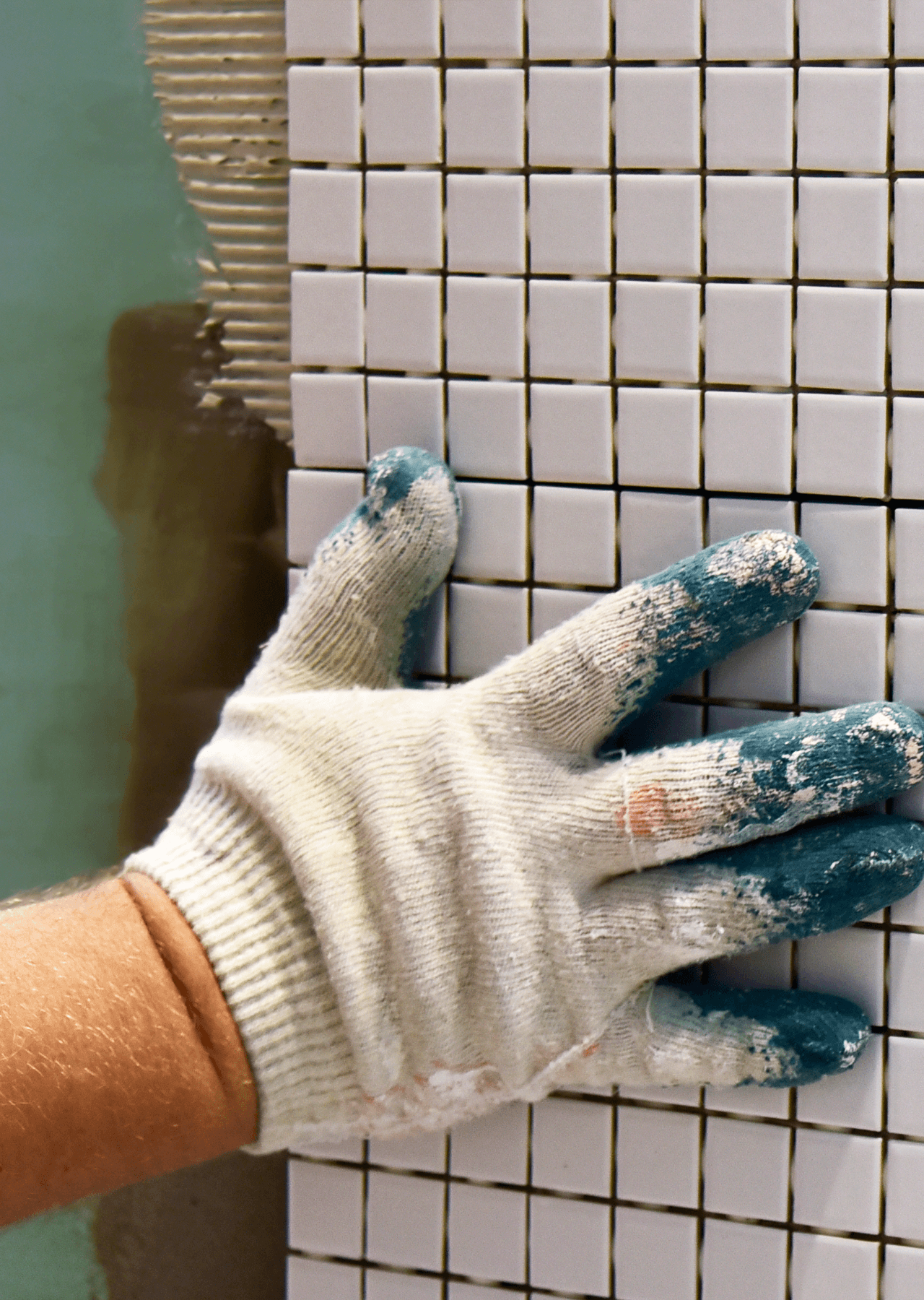



Using A Levelling System
For a professional-grade finish to your tiling job, we recommend you use a tile levelling system. We recommend our DTA Tile Levelling Starter Kit. Tile levelling systems are great when tiling a main floor with large, rectified tiles and can make the job a lot easier. The upright clip component is often available in a variety of widths and will double as a spacer to set the grout width. The wedge or cap will ensure the tile surface is level with the adjacent tile and help to remove any lipping (uneven surfaces).
The cap or wedge clamps down on the upright and the tile surface to achieve a flat tiled surface. Always follow the manufacturer’s instructions and use a spirit level to ensure the floor remains level.
The levelling system is left in place while the adhesive dries. When fully dry, the wedges or caps are removed and the protruding uprights are knocked out (carefully in the direction of the grout joints).
Our Hot Tip: We’ve tried and tested the best levelling systems from around the world. Check out our range here.
Tile Spacers & Grout Width
Grout spacers are a fantastic way to ensure your grout lines remain straight and even and are available from all Beaumonts stores. They are available in various sizes, for 1.5mm, 2mm and 3mm width joints.
Grout spacers are not embedded in the grouting but are placed with one arm into the gap between the tiles (one at each end of all large tiles) during installation. This ensures each tile is separated and that the gap remains constant until the adhesive sets. All the spacers must be removed once the tile adhesive has dried and prior to grouting.
If you are using a tile levelling system, the upright will also serve as a tile spacer to maintain even grout joints.
We recommend a grout width of around 3mm for pressed edge floor tiles and no less than 1.5mm for wall tiles. Outdoor tiling, but especially terracotta and quarry tiles (classed as extruded tiles) will typically have wider joints. The Australian Standard AS3958-2023 recommends that extruded tiles should have grout joints of 6mm.
Rectified porcelain floor tiles and natural stone tiles laid indoors can be installed with narrow joints of 1.5mm to 2mm but will generally be installed with a tile levelling system to ensure there is no lippage and the tile surfaces remain flat and level. Care must be taken when grouting a tile installed with narrow joints to ensure that the grout penetrates and fills the joint spaces fully. When narrow joints are used, ensure a flexible adhesive is used and importantly that there are appropriate movement joints incorporated at the recommended intervals and wherever the tiles meet an adjoining surface.
The grout width must allow for the standard variance in the tile dimensions. All clays shrink slightly when fired so there can be small differences from tile to tile. A larger tile may have a slightly larger variation if it is not a rectified tile. Small differences in size will be highlighted if the grout joint is too narrow as will any lippage if one tile sits slightly higher than the next. This is why we recommend using a tile levelling system for professional results, especially with narrower grout joints. If you use the same floor tile also on the wall, the grout width should be kept the same as the floor.
Our Hot Tip: For detailed instruction on how to grout tiles, download our DIY Tiling Guide here.




How To Use A Rubber Grouter
Using a rubber grouter makes the task of grouting tiles much easier.
A rubber grouter also referred to as a grout float, is a simple hand tool designed to make applying grout easier in the spaces between tiles, mosaic and natural stones. It is light with a firm, flat base and often tapered to a pointed end to make filling joints and corners easier.
A standard rubber grouter is compatible with most types of tiles and cement-based grouts. Epoxy grout requires the use of a specialised grout float due to its sticky nature.
The mixed grout is normally transferred from the mixing bucket onto the floor or wall with a hand trowel then the grout float is used to spread out the grout, forcing it into the spaces between tiles. Since the grout float base is made from rubber, the tiles will not be scratched or chipped when the grout is applied.
Hold the grout float at 45 degrees to the floor and apply the grout in firm, diagonal strokes across the grout lines. Make sure you cover the entire surface including all the tile with grout. Work in small areas at a time rather than trying to cover the whole area at once.
Once the joints are filled, remove excess grout from the tile surface by wiping the grout float at 90 degrees diagonally across the tile surface. This will make cleaning up easier when you finish applying the grout to the area
Our Hot Tip: You can use a grout float to press mosaic tiles into adhesive. The wider, flat surface makes it easier to achieve a flat, uniform surface in mosaics.
The Top 10 Fixing Tips
Our handy DIY Guide has all the information you need, you can download it and have our tips on hand. It contains even more fixing tips.
- Check all boxes of tiles match your selection, have an acceptable shade blend and you have enough for the job, with 10% spares.
- Tiles must be dry and clean - no loose powder.
- The surface of the tile needs to be structurally sound, flat and free from grease, wax, oil, curing compounds and all forms of contamination.
- Apply adhesive with the right notched trowel for the job.
- Press tiles firmly into the adhesive bed with a slight sliding motion across the ribs. The whole of the back of the tile must be in good contact with the adhesive.
- Remove a tile from time to time to check that complete contact with the adhesive is made.
- Do not fix tiles onto an adhesive that has already begun to dry or has skin on the top.
- Allow the adhesive to set before grouting, usually not less than 24 hours.
- Use adhesive and grout strictly under the manufacturer’s directions.
- Tiles must not be kept in direct sunlight before laying.
Our Hot Tip: Appropriate movement joints must be used and construction joints must not be tiled over.




10 Things NOT To Do When Fixing
Our handy DIY Guide has all the information you need, you can download it and have our tips on hand.
- Incorrect or no expansion joints: failure to use the correct expansion joints and tiling over construction joints will make your tiles too rigid, and they will crack or buckle during movement or expansion and contraction of the building.
- Incorrect choice of adhesive. This is one of the most common causes of tile fixing failure that we see. See our page on How to Choose Grout and Adhesives for more information.
- Allowing the adhesive to dry out before fixing the tiles.
- Contaminated background. Ensure that the surface and area that you are tiling is properly cleaned before commencing tiling.
- Poor or incorrect surface preparation.
- Poor adhesive coverage. This can result from not using the correct notched trowel, using the spot-fixing method, or allowing voids behind the tiles.
- Unsatisfactory bed thickness. Ensure that you use the correct notched trowel when applying adhesive.
- Excessive movement in the substrate.
- Dust or lose backwash not removed from the backs of tiles. Ensure that the backs of tiles are clean and dry before laying tiles.
- An incorrect mixing ratio of adhesive powder and liquid. Always follow the manufacturer's directions, and always add the adhesive to the water to ensure a smooth mixture.
Our Hot Tip: Surface preparation is key when you are about to start fixing your tiles. If in doubt, contact your local Beaumont store for expert help.


Tiling Kitchen Floors
Kitchens are the centrepiece of most homes. Lots of love and the occasional spill happens when preparing meals for the family and of course, tiles can take whatever your kitchen can dish out.
From food spills, wine spills, to accidents like a dishwasher overflowing, tiles are made to take the tough stuff.
How To Tile a Main Floor (links to above) has all the information you need to tile your kitchen are as well.
Our Hot Tip: Our DIY experts have created a super handy DIY guide that will be your best friend throughout your DIY journey - click here to download(LINK).
